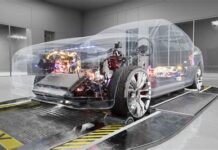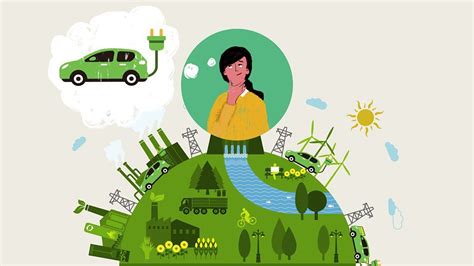As we navigate an increasingly eco-conscious world, electric vehicles (EVs) are emerging as a key solution to reduce carbon emissions and promote sustainable transportation. This article delves into the transformative landscape of electric vehicles, highlighting the factors fueling their rapid adoption and the common challenges that lie ahead. From infrastructure hurdles to advancements in battery technology, we will explore the intricate dynamics shaping the future of EVs. Furthermore, we’ll address consumer concerns, including range anxiety and misconceptions, while examining the critical influence of government policies on wider adoption. Join us on this journey as we uncover the potential of electric vehicles to drive us toward a cleaner, greener future while acknowledging the obstacles that must be overcome to ensure their success.Understanding The Rise Of Electric Vehicles In The Market
The surge in popularity of electric vehicles (EVs) can be attributed to a confluence of factors that align with consumer needs and global environmental goals. As more individuals become aware of the electric vehicle future problems, there is a growing demand for sustainable and efficient transportation solutions.
One of the primary drivers of this rise is the increasing concern about climate change. Consumers are more environmentally conscious than ever, leading to a shift in preference towards zero-emission vehicles. This societal trend is supported by significant advances in battery technology that improve vehicle performance and reduce costs, making EVs a more viable choice for everyday consumers.
Moreover, government incentives and regulations play a crucial role in fostering the adoption of electric vehicles. Many governments globally are setting ambitious targets for phasing out traditional internal combustion engines, coupled with attractive subsidies for EV purchases and investments in charging infrastructure. This creates a conducive environment for potential buyers to shift from gasoline-powered vehicles to electric options.
The automotive industry is also witnessing some major players transitioning their production lines to focus on electric vehicle models. This competitive landscape encourages innovation and increased investment in research and development, further promoting the widespread acceptance of electric vehicles.
In addition to these factors, the rise of shared mobility services and advancements in autonomous driving technology have led to a reevaluation of transportation modes. EVs are often seen as the future of shared mobility solutions, contributing to their growth in popularity.
In summary, the rise of electric vehicles in the market is underscored by a combination of environmental awareness, governmental support, technological advancements, and changing consumer preferences. As these trends continue to evolve, it will be crucial to address the electric vehicle future problems that accompany this rapid transition.
Key Factors Driving The Adoption Of Electric Vehicles
The transition to electric vehicles (EVs) is driven by various interconnected factors that cater to consumer needs, environmental awareness, and technological advancements. Understanding these elements is crucial to recognizing the dynamic shift toward EVs and the electric vehicle future problems that may arise.
Each of these factors plays a significant role in shaping the landscape of electric vehicle adoption. However, as the demand grows, it is essential to address the electric vehicle future problems that may surface as a result of these changes, ensuring a sustainable path forward for both consumers and manufacturers.
Electric Vehicle Future Problems: Infrastructure Challenges Ahead
The rapid growth of the electric vehicle (EV) market is accompanied by an array of electric vehicle future problems, notably concerning infrastructure. As more consumers embrace EVs, the infrastructure required to support them must evolve in parallel. Here are some of the key challenges ahead:
| Challenge | Description | Potential Solutions |
|---|---|---|
| Charging Station Availability | Limited availability of charging stations can deter potential EV buyers and create range anxiety. | Government incentives for new installations and partnerships with private enterprises. |
| Grid Capacity | The existing electrical grid may struggle to handle the increased load from widespread EV charging. | Investment in grid modernizations and renewable energy sources to meet demand. |
| Standardization of Charging Technology | Lack of unified charging standards can lead to compatibility issues across different EV brands. | Collaboration within the industry to establish common charging protocols. |
| Urban Planning and Accessibility | Many urban areas lack the necessary infrastructure to support EV charging, especially in multi-family dwellings. | Incorporating charging facilities into urban development plans and retrofitting older buildings. |
| Public Awareness | Many consumers are still unaware of the availability and benefits of EV charging infrastructure. | Educational campaigns and community engagement to promote EV technologies. |
Addressing these electric vehicle future problems is essential for ensuring the transition to electric mobility is both feasible and attractive. With the right investments and innovative approaches, it is possible to build an infrastructure that not only supports current demand but is also scalable for future growth.
Battery Technology Advancements And Their Impact On EV Performance
As the electric vehicle industry matures, one of the most critical factors impacting its viability and appeal is the evolution of electric vehicle future problems related to battery technology. Significant advancements in this area are not only enhancing the performance of electric vehicles but are also addressing some of the pressing challenges faced by consumers and manufacturers alike.
Recent developments focus on several key aspects of battery technology, including energy density, charging speed, lifespan, and sustainability. The table below outlines these advancements and their implications on EV performance:
| Advancement | Description | Impact on EV Performance |
|---|---|---|
| Higher Energy Density | Improvements in battery chemistry allow more energy to be stored in the same amount of space. | Increased driving range per charge, reducing range anxiety. |
| Faster Charging Technology | Innovations in fast-charging solutions reduce downtime for recharging. | Enhances convenience and makes electric vehicles more accessible for long trips. |
| Improved Lifespan | New battery designs focus on longevity and reduced degradation over time. | Lower cost of ownership and increased consumer confidence in EV reliability. |
| Sustainable Materials | Research into alternative materials aims to minimize environmental impact. | Enhances public perception and addresses environmental concerns. |
These advancements are crucial in tackling various electric vehicle future problems. Enhanced energy density not only extends the range of electric vehicles but also minimizes the frequency of charging stops, an essential factor for many consumers hesitant to switch from gasoline-powered cars. Similarly, fast-charging technologies reduce the time spent at charging stations, making electric vehicles a more practical option for everyday use.
Additionally, a focus on improved battery lifespan means that consumers can enjoy their electric vehicles longer without the need for costly battery replacements, further incentivizing adoption. Sustainable battery production techniques may also alleviate concerns about the environmental impact of battery disposal, aligning electric vehicle growth with ecological responsibility.
As battery technology continues to evolve, it plays a pivotal role in shaping the future of electric vehicles. By addressing key issues that contribute to electric vehicle future problems, these advancements not only enhance performance but also help solidify the position of electric vehicles as a viable alternative to traditional combustion engines.
Addressing Range Anxiety In Electric Vehicle Users
One of the most significant hurdles in the widespread adoption of electric vehicles (EVs) is the concern known as range anxiety. This fear arises from the uncertainty surrounding how far an electric vehicle can travel on a single charge and the availability of charging stations along potential routes. Addressing this issue is crucial for mitigating electric vehicle future problems.
To effectively counter range anxiety, several strategies and advancements are being pursued:
- Expansion of Charging Infrastructure: Governments and private firms are investing heavily in building a comprehensive network of charging stations. These are increasingly being located in urban areas, along highways, and at popular travel destinations to ensure that drivers have accessible options for recharging.
- Fast Charging Solutions: Technological advancements have led to the development of fast charging stations, significantly reducing the time it takes to charge an EV. Many of these stations can provide about 80% charge in just 30 minutes, making long-distance travel more feasible.
- Enhanced Battery Technology: Ongoing improvements in battery capacity and efficiency mean that newer EV models are capable of traveling longer distances on a single charge. Manufacturers are also working on developing solid-state batteries, which promise even greater range and quicker charging times.
- Real-Time Charging Availability Apps: Applications that provide real-time data on charging station availability can help users plan their journeys more effectively. These apps often include features like route mapping, nearest charging location, and reservation capabilities.
By focusing on these key areas, the electric vehicle industry can alleviate concerns about range anxiety, making EVs a more attractive option for consumers. As these advancements develop and become more widespread, addressing electric vehicle future problems will continue to be a priority, paving the way for improved consumer confidence in electric vehicle usage.
The Role Of Government Policies In Shaping EV Adoption
Government policies play a crucial role in shaping the adoption of electric vehicles (EVs) by addressing electric vehicle future problems and incentivizing consumers and manufacturers alike. Through various strategies, governments around the world have implemented measures that significantly impact the growth of the EV market.
One of the primary approaches is the introduction of financial incentives, such as tax credits and rebates for EV buyers. These incentives reduce the overall purchase cost of electric vehicles, making them more attractive compared to traditional gas-powered models. For instance, countries like Norway and the Netherlands have successfully employed such policies, resulting in a substantial increase in EV sales.
Additionally, government investment in charging infrastructure is vital. By enhancing the availability and accessibility of charging stations, governments can effectively alleviate concerns regarding range anxiety, a significant barrier to electric vehicle adoption. Efficient charging networks encourage potential users to consider EVs as a viable alternative, promoting a smoother transition towards electric mobility.
Moreover, stringent emissions regulations and targets set by authorities can compel automakers to shift their focus toward the development of electric vehicles. This push toward sustainability aligns with global efforts to combat climate change, requiring manufacturers to innovate and produce cleaner vehicles.
International climate agreements also bolster government policies, as nations commit to reducing greenhouse gas emissions. These agreements often lead to stricter local regulations supporting electric vehicle adoption and creating a more favorable market environment.
The synergistic effect of thoughtful government policies—ranging from financial incentives to infrastructure investment—will be pivotal in overcoming the electric vehicle future problems. As these policies evolve, they will undoubtedly shape the landscape of the automotive industry, accelerating the transition towards electric mobility and contributing to a more sustainable environment.
Exploring Cost-Effectiveness Of Electric Vehicles Over Time
As the automotive industry continues to evolve, the electric vehicle future problems play a pivotal role in understanding the long-term cost implications of adopting electric vehicles (EVs). Initially, the purchase price of electric vehicles can be higher than their gasoline counterparts; however, looking closely at the total cost of ownership reveals a different picture.
One of the primary advantages of EVs is their reduced operating costs. Electric vehicles tend to have fewer moving parts than internal combustion engine vehicles, leading to lower maintenance expenses. According to various studies, the maintenance costs for electric vehicles can be up to 40% less than traditional vehicles over the lifetime of the car. Additionally, EV owners benefit from the inherently lower energy costs related to electricity compared to gasoline, which can further enhance cost savings.
Another important factor to consider is the resale value of electric vehicles. With the growing demand for EVs, many models hold their value well. Market trends indicate that as technology improves and the charging infrastructure expands, the resale value for EVs is expected to remain competitive compared to traditional vehicles.
Government incentives also significantly impact the cost-effectiveness of electric vehicles. Many countries offer tax rebates or grants that can effectively reduce the price of purchasing an EV. Furthermore, various states provide incentives such as access to carpool lanes and reduced registration fees. These financial benefits can greatly enhance the overall affordability of electric vehicles for consumers.
However, the future challenges related to electric vehicles should not be overlooked. As the demand for EVs increases, concerns regarding the sustainability of battery production and disposal may arise, potentially influencing long-term costs and environmental impact. The advancement of battery recycling technologies will play a crucial role in addressing these concerns.
While there are initial costs associated with purchasing an electric vehicle, the long-term advantages such as lower maintenance costs, government incentives, and rising resale values position EVs as a cost-effective alternative to traditional vehicles. As technology advances and the market adapts, understanding the financial dynamics will be essential in navigating the landscape of electric vehicles and their associated electric vehicle future problems.
Environmental Impact Of Electric Vehicle Production And Disposal
The shift towards electric vehicles (EVs) has been celebrated for its potential to reduce greenhouse gas emissions and dependence on fossil fuels. However, a closer examination of the environmental impact of electric vehicle production and disposal reveals significant challenges that need to be addressed as we consider their role in the future of transportation.
One of the primary concerns relates to the sourcing and processing of materials used in electric vehicle batteries, particularly lithium, cobalt, and nickel. These minerals are often extracted through mining processes that can lead to habitat destruction, water pollution, and substantial carbon emissions. Additionally, the energy-intensive nature of battery production raises questions about the source of this energy, as many facilities still rely on fossil fuels. Thus, the electric vehicle future problems encompass not only the carbon footprint during usage but also the impacts felt during the production phase.
Moreover, the disposal of electric vehicle batteries poses another significant challenge. While advancements in recycling technology are being made, the current systems often fall short, leading to a considerable number of batteries ending up in landfills. The potential for soil and water contamination from hazardous materials contained in these batteries cannot be overlooked. As this sector grows, establishing effective recycling processes will be crucial in mitigating these environmental risks.
To address these issues, a comprehensive approach must be adopted. Manufacturers can explore sustainable mining practices, invest in battery recycling innovations, and consider alternative materials that lessen environmental damage. Consumers, on their part, should also be educated about the life cycle of electric vehicles and the importance of recycling old batteries.
While electric vehicles offer a promising alternative to traditional combustion engines, they are not without their environmental impacts. By acknowledging and proactively addressing these electric vehicle future problems, the industry can work towards a more sustainable and responsible future for transportation.
Consumer Education: Tackling Misconceptions About Electric Vehicles
As the adoption of electric vehicles (EVs) accelerates, it is essential to address the common misconceptions that often deter potential buyers. Misunderstandings about electric vehicle future problems can create barriers to entry for consumers. Here are some key misconceptions and the truths that counter them:
- Concern: Electric vehicles have limited driving range. Many consumers believe that EVs cannot travel long distances. In reality, advancements in battery technology are continually extending the ranges of electric vehicles, making them more viable for everyday use and long-distance travel.
- Concern: Electric vehicles are too expensive. While the initial cost of an EV may be higher than that of a traditional vehicle, the total cost of ownership often favors EVs due to lower fuel, maintenance, and tax benefits. Furthermore, prices are expected to decline as technology improves and production scales up.
- Concern: Charging an electric vehicle is inconvenient. Although charging an EV may take longer than refueling a gasoline car, the convenience of home charging offers significant advantages. Public charging networks are also expanding rapidly, making charging stations more accessible.
- Concern: Electric vehicles are not environmentally friendly. Many people worry about the environmental impact of EVs. It is important to recognize that while the production and disposal of batteries pose challenges, an electric vehicle’s lifetime emissions are typically lower than traditional vehicles, especially when powered by renewable energy sources.
- Concern: Electric vehicles are sluggish compared to gasoline cars. In fact, many electric vehicles offer impressive acceleration and performance due to the immediate torque provided by electric motors, making them competitive with or superior to their gasoline counterparts.
Tackling these misconceptions through consumer education is vital for promoting electric vehicle adoption. Providing accurate information and addressing fears can empower consumers to make informed choices about transitioning to electric vehicles, ultimately aiding in overcoming some of the electric vehicle future problems we face today and will encounter tomorrow.
Future Innovations To Overcome Electric Vehicle Problems
The journey towards a fully evolved electric vehicle ecosystem is accompanied by several electric vehicle future problems. However, with continuous advancements in technology and innovation, the automotive industry is poised to tackle these challenges effectively. Here are some of the most promising innovations that could help alleviate the issues facing electric vehicles:
- Solid-State Batteries: These batteries are expected to replace traditional lithium-ion batteries with lighter, safer, and more efficient alternatives. They promise faster charging times and longer ranges, which could dramatically reduce range anxiety.
- Wireless Charging Technologies: Implementing inductive charging systems could minimize the need for conventional charging infrastructure. This innovation allows vehicles to charge while parked over a special pad, making electric vehicle usage more convenient.
- Smart Charging Solutions: These systems can optimize the charging process by automatically adjusting based on electricity demand, costs, and grid capacity. This helps to prevent grid overloads and makes charging more cost-effective.
- Vehicle-to-Grid (V2G) Technology: This technology enables electric vehicles to return energy to the grid when not in use. By acting as mobile battery storage, EVs can support renewable energy integration and stabilize energy supply.
- Advanced Materials: The adoption of lightweight and recyclable materials in vehicle manufacturing can improve energy efficiency and reduce waste at the end of a vehicle’s life. This approach tackles both performance and environmental concerns.
- AI and Machine Learning: Utilizing AI to analyze driving patterns and optimize battery usage can enhance the overall driving experience. Additionally, AI can help manufacturers predict and address maintenance needs before issues arise.
Through these innovations, the electric vehicle industry can address its most pressing electric vehicle future problems. Collaborations between automakers, technology companies, and policymakers will be crucial in driving these advancements forward, ensuring a sustainable and efficient future for electric mobility.
Frequently Asked Questions
What advancements can we expect in electric vehicle technology in the near future?
In the near future, we can expect advancements in battery efficiency, faster charging technologies, and enhanced autonomous driving capabilities, which will make EVs more practical and widespread.
What are some common problems faced by electric vehicle owners?
Common problems include range anxiety, longer charging times compared to refueling gasoline vehicles, limited charging infrastructure, and potential battery degradation over time.
How are manufacturers addressing charging infrastructure issues?
Manufacturers are collaborating with governments and private companies to expand public charging networks, invest in fast-charging stations, and develop home charging solutions to alleviate driver concerns.
Can electric vehicles compete with traditional internal combustion engine vehicles in terms of performance?
Yes, many electric vehicles currently outperform traditional internal combustion engine vehicles in acceleration and torque due to the instant power delivery of electric motors.
What role does government policy play in the future of electric vehicles?
Government policies, including incentives for buyers, emissions regulations, and investments in charging infrastructure, are crucial in accelerating the adoption of electric vehicles.
How is the battery technology for electric vehicles evolving?
Battery technology is evolving with the development of solid-state batteries, advancements in lithium-ion chemistry, and research into alternative materials, all aimed at increasing energy density and reducing costs.
What environmental impacts should be considered with electric vehicles?
While EVs produce fewer emissions during operation, it’s essential to consider the environmental impact of battery production, the sourcing of raw materials, and the lifecycle emissions from electricity generation.













